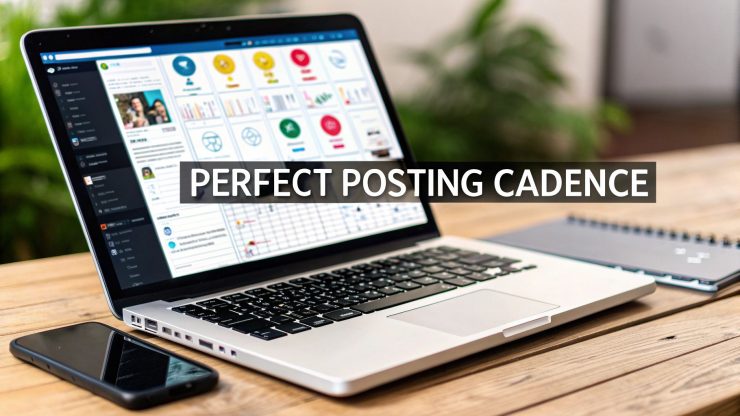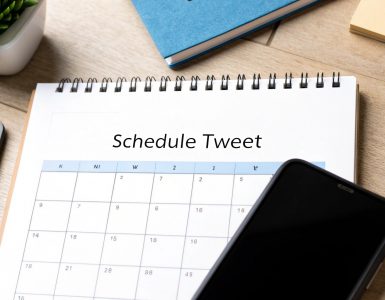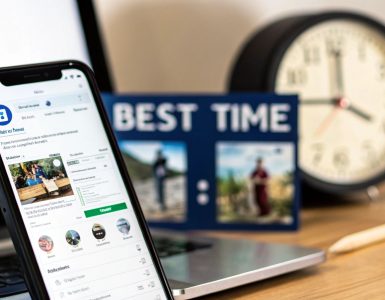Everyone is looking for that magic number—the perfect formula for how often to post on social media. But here's the honest truth from someone who's been in the trenches: there isn't one. The ideal social media posting frequency is less about hitting a quota and more about striking a natural balance between quality and consistency. It’s about keeping a conversation going, not just shouting into the void.
Finding Your Social Media Cadence

Think of your posting schedule less like a rigid recipe and more like learning a dance. You have to find a rhythm that feels right for both your brand and your audience. Post too much, and you risk annoying your followers with what feels like spam. This "content fatigue" is a real thing, and it leads straight to the unfollow button.
But if you post too little, your brand can feel distant or, worse, completely inactive. You lose that precious top-of-mind awareness and all the momentum you’ve built.
The real goal is to find that sustainable sweet spot—a pace where you can consistently deliver genuinely valuable content without burning out your team or overwhelming your followers. This is where the old saying "quality over quantity" isn't just a cliché; it's your North Star. A handful of truly engaging posts that get people talking will always beat a dozen mediocre ones that get scrolled past.
Platform-Specific Starting Points
Every social media platform is its own little world. Each one has a unique culture, a distinct algorithm, and completely different user expectations. This means a one-size-fits-all posting strategy just won't work. What's perfect for the fast-paced, in-the-moment feel of one network is totally wrong for the polished, professional vibe of another.
For instance, the optimal frequency can vary wildly. On Instagram, many brands find success with 3 to 5 main feed posts per week, supplemented by up to two Stories each day. Over on Facebook, the sweet spot is often 1 to 2 posts per day. LinkedIn's professional crowd tends to engage well with 1 to 2 posts daily, while even newer players like Threads have found their rhythm, with most experts suggesting 1 to 2 posts per day to stay on people's radar. You can dig deeper into these kinds of numbers by exploring research on social media trends at talkwalker.com.
To help you get started, I've put together some data-backed recommendations. Think of these as a reliable baseline—a solid place to begin your journey. From here, you can start testing, learning, and fine-tuning your approach based on how your own audience responds.
Recommended Posting Frequency At a Glance
Use this table as a starting point to guide your social media posting frequency on major platforms.
| Platform | Recommended Daily Posts | Recommended Weekly Posts |
|---|---|---|
| 0-1 Post, 2 Stories | 3-5 Feed Posts | |
| 1-2 Posts | 7-10 Posts | |
| TikTok | 1-4 Posts | 3-5+ Posts |
| X (Twitter) | 2-3 Posts | 15-20 Posts |
| 1-2 Posts | 5-10 Posts | |
| 1-3 Pins | 7-21 Pins |
Remember, these numbers are your launchpad, not your destination. The best social media managers treat these as hypotheses and let their own data tell them what truly works.
Why Posting Frequency Is a Conversation, Not a Quota
It’s easy to fall into the trap of treating social media posting like a chore—something you have to check off a list every day or week. But thinking of it as a social media posting frequency quota is one of the fastest ways to lose touch with your audience. A better way to frame it is as an ongoing conversation. It's a living, breathing exchange where you have to listen as much as you talk.
Think about it like you're at a party. You know that one person who just won't stop talking? They dominate every discussion and never let anyone else get a word in. Pretty soon, everyone starts to tune them out. That's exactly what happens when you post too much. You overwhelm your followers' feeds, and they start to feel content fatigue, which can lead to a quick mute or, worse, an unfollow.
But what about the person who hangs back in the corner and never says a word? They seem distant, almost unapproachable. That’s the risk of posting too little. Your brand starts to feel like a forgotten friend, and that connection you worked so hard to build just fizzles out. Your audience might even wonder if you're still in business.
Finding a Rhythm That Resonates
The real goal is to find a posting rhythm that feels just right for your audience. This isn't about throwing content at a wall to see what sticks; it's about publishing when your followers are actually online and ready to listen. It’s about joining their daily flow instead of just interrupting it.
This is exactly what social media algorithms are built to reward. They don't just count your posts. They're much smarter than that. They measure the real-world engagement your content generates—the likes, comments, shares, and saves. They're looking for signs that you're sparking genuine, valuable interaction.
A consistent, predictable posting cadence sends a powerful signal to both the algorithm and your audience: you are a reliable source. This builds trust and trains your followers to actually look forward to your content, turning them from passive scrollers into a real community.
Of course, making this a true conversation means being thoughtful about what you share. It's always a good idea to review some basic social media content precautions before you post, ensuring your contributions are not just frequent but also responsible.
It's About Value, Not Volume
The most important mental shift you can make is from volume to value. Every single post you publish needs to have a purpose. Before you hit "schedule," take a second to ask yourself if your content is actually doing a job for your audience and your brand.
- Is this actually helpful? Does it solve a real problem or answer a common question?
- Is this genuinely entertaining? Will it make someone smile, laugh, or feel inspired?
- Is this truly informative? Are you teaching your followers something new about your niche?
- Does this build a real connection? Does it offer a peek behind the curtain or share a story that humanizes your brand?
If a post doesn't check at least one of those boxes, it's probably just adding to the noise. It’s far more effective to publish three knockout posts a week that get people talking than seven forgettable ones that get scrolled right past.
This entire approach depends on a deep understanding of how often to post on social media based on the value you're providing, not just a rigid schedule. When you get this right, your content strategy transforms from a simple checklist into a meaningful dialogue that builds lasting relationships and drives real growth.
Tailoring Your Posting Frequency for Each Platform
If you’re posting the same content at the same pace across all your social media channels, you’re missing a huge opportunity. Think of it like this: you wouldn't wear a tuxedo to a backyard BBQ. Each social platform has its own vibe, its own algorithm, and its own audience expectations. To get real traction, you have to read the room and adapt your cadence accordingly.
What kills it on the lightning-fast, trend-driven world of TikTok would feel completely tone-deaf on the polished, professional network of LinkedIn. One demands quick, in-the-moment content, while the other rewards thoughtful, in-depth analysis. Ignoring these core differences isn't just inefficient—it can actually work against you. That’s why a custom approach isn’t just a nice-to-have; it's absolutely essential for seeing results.
The infographic below really drives this point home, showing just how much engagement can vary from one network to the next.
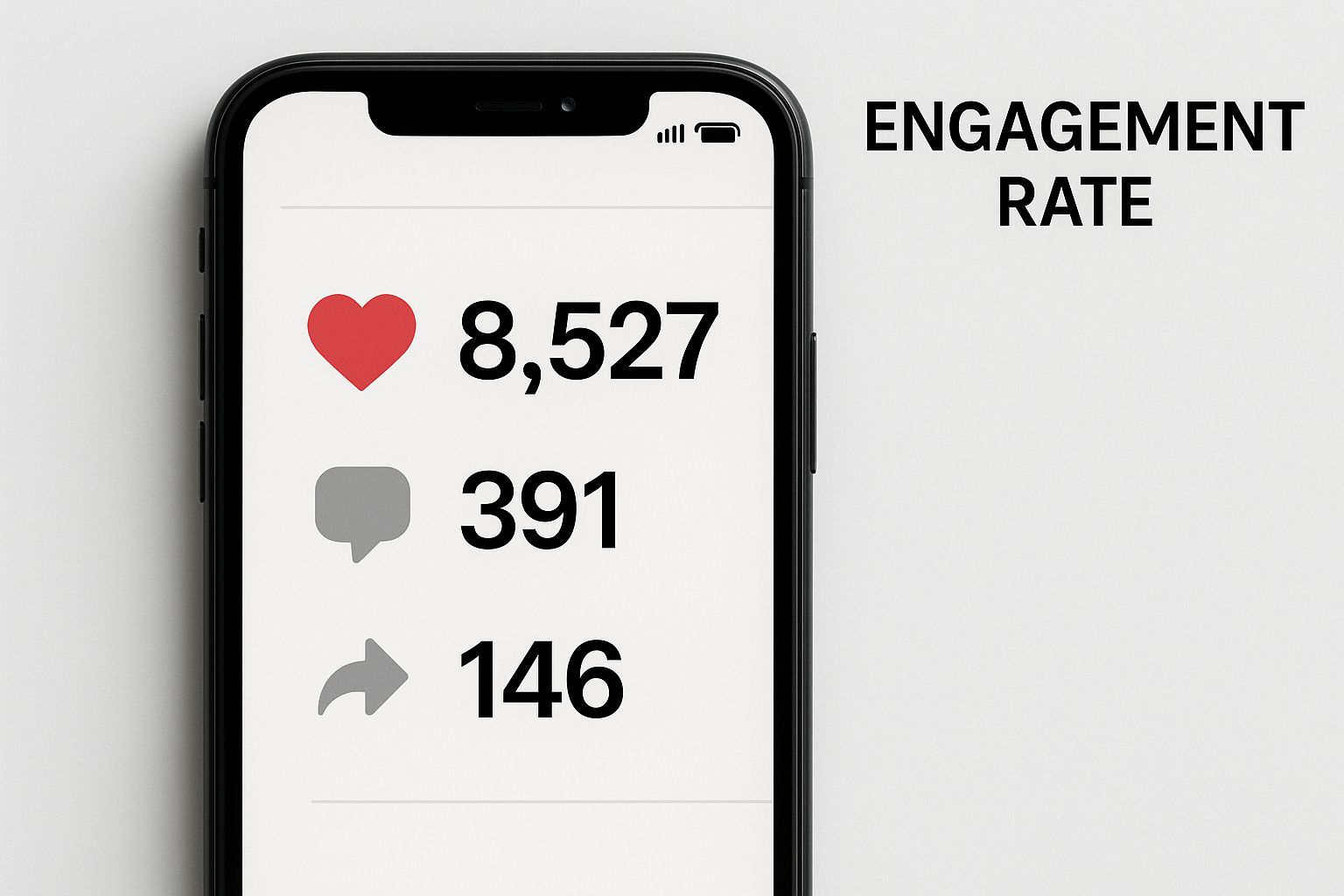
As you can see, metrics aren't universal. This reinforces the need to adjust your posting rhythm to what actually works on each channel.
X (Formerly Twitter): The High-Speed News Ticker
X moves at a blistering pace. The lifespan of a single post is incredibly short, so you need to post more frequently just to stay on people’s radar. It’s all about real-time conversations, breaking news, and quick takes.
- Recommended Frequency: A good starting point is 2-3 posts per day.
- Why It Works: With a chronological and fast-moving feed, consistent posting is the only way to stay in your audience's immediate view. It's less about every single post being a work of art and more about maintaining a steady presence.
- Pro-Tip: Don't just broadcast. True X engagement comes from replies, retweets, and jumping into conversations. Mix these in with your own original content.
Facebook: The Community Hub
Facebook has really settled into its role as a space for building communities. While organic reach can be a tough nut to crack these days, the platform still prioritizes content that sparks genuine conversation and connection. A steady, but not overwhelming, pace is what you're aiming for.
- Recommended Frequency: We've found that 1-2 times per day is the sweet spot for most businesses.
- Why It Works: This is just enough to keep your brand top-of-mind without annoying your followers with a flooded feed—a quick way to get an unfollow. Every post should offer real value to encourage comments and shares.
- Pro-Tip: Leverage Facebook Groups. You can create a dedicated community space where you can engage on a much deeper level and post more niche content more often than you would on your main page.
Instagram: The Visual Showcase
Instagram is all about visuals, where great aesthetics and compelling storytelling win the day. But figuring out the best posting frequency here is a bit tricky because different formats play by different rules.
Key Insight: You can't treat your Feed, Stories, and Reels as the same thing. Each needs its own rhythm. A Reel can get traction for days, while a Story is gone in 24 hours.
Here’s a simple breakdown:
- Feed Posts: Aim for 3-5 times per week. These are your high-quality, "shop window" posts. Quality is far more important than quantity here.
- Stories: Feel free to post up to 2 times per day. Stories are perfect for casual, behind-the-scenes content. Because they disappear, you can post more often without cluttering anyone's main feed.
- Reels: Start with 2-4 times per week. Reels are your best bet for reach and discovery right now, and the algorithm tends to reward consistent creators.
LinkedIn: The Professional Network
On LinkedIn, quality and authority are everything. This is the B2B powerhouse where people come for industry insights, career advice, and professional connections. Posting too often or with low-quality content will torpedo your credibility fast.
- Recommended Frequency: Posting 1-2 times per day during the workweek is highly effective.
- Why It Works: The LinkedIn algorithm gives good content a much longer shelf life. A single, insightful post can keep circulating for days as people in your network and beyond comment on and share it.
- Pro-Tip: Mix up your content formats. A punchy text-only post can do just as well as one with an image or document. Experiment with polls, articles, and carousels to see what your audience responds to.
TikTok: The Entertainment Engine
TikTok is driven by fast trends, raw authenticity, and pure entertainment. The "For You" page is designed to deliver a non-stop firehose of new content, which means brands have to keep pace to stay relevant.
An analysis of over 125 million posts showed TikTok leading the pack with an average organic engagement rate of 2.50%. However, that same study found that overall engagement is on the decline elsewhere—down 36% on Facebook and a massive 48% on X. This has led brands to adjust, posting a bit more on TikTok while pulling back on other platforms.
- Recommended Frequency: Aim for 3-5+ times per week. If you have the content, even daily posting can work wonders.
- Why It Works: The more you post, the more data you feed the algorithm, helping it find your ideal audience faster. It’s a platform built for experimentation, so don’t be afraid to try out different ideas and see what sticks.
Remember, your social media activity doesn't exist in a vacuum. To get the best results, think about how it all fits into your broader omnichannel communication strategy to ensure a consistent and powerful brand voice everywhere your customers see you.
How to Discover Your Brand’s Perfect Rhythm
General advice on social media posting frequency is a great starting point, but let’s be honest—the real wins come when you move from following guidelines to creating your own. True success comes from a strategy that fits your brand and your specific audience like a glove. Think of yourself as a data detective, digging into your own analytics to find that sweet spot.
This isn't about throwing content at the wall and seeing what sticks. It's about listening to what your followers are already telling you through their actions. Native tools like Instagram Insights or the Facebook Business Suite are your best friends here, revealing the story behind your performance. By diving into this data, you can stop guessing and start making decisions based on solid evidence.
Start With a Simple Audit
Before you can figure out your ideal posting rhythm, you need a clear snapshot of where you are right now. A simple content audit is the perfect first step. Don't overcomplicate it; you're just trying to get a baseline to understand what’s working and what’s not.
Your goal is to set a benchmark. This gives you a clear point of comparison for any experiments you run later. Without this initial data, you’re flying blind and won't be able to tell if your changes are actually making a difference.
To get started, pull up your posts from the last 30 to 90 days and track these key performance indicators (KPIs):
- Engagement Rate Per Post: This shows how much your audience is actually interacting with your content. You can calculate it by dividing the total engagements (likes, comments, shares) by your total followers.
- Reach Per Post: This tells you how many unique accounts saw your content. It’s a crucial metric for understanding brand awareness.
- Follower Growth or Decline: Keep an eye on how your follower count changes over time. Are certain posting patterns causing spikes or dips?
- Best Performing Content: Pinpoint the top 3-5 posts from this period. Look for patterns. Was it the topic, format, or the time of day you posted?
Designing Your A/B Test
Once you have your baseline, it’s time for the fun part: experimenting. An A/B test is just a straightforward way to compare two different strategies to see which one works better. In this case, you’ll be testing different posting frequencies.
Here’s a practical, step-by-step process:
- Form a Hypothesis: Start with a clear question. For instance: "Will posting on Instagram five times a week instead of three increase our average engagement rate?"
- Change One Variable: For two weeks, bump up your posting frequency from three to five times per week. Keep everything else the same. Your content themes, formats, and posting times should stay consistent with what you were doing before.
- Run a Control Group (Optional but Recommended): If you manage multiple platforms, you can run the test on one (like Instagram) while keeping your frequency on another (like Facebook) the same. This helps confirm the changes you're seeing are from the test itself.
- Measure and Compare: After the two-week test, gather the same KPIs you tracked in your audit. Now, compare the results from your test period to your baseline data.
The goal isn't just to see if the numbers changed, but to understand why they changed. Did more posts lead to more engagement, or did it cause content fatigue and a drop in reach per post? The answer is waiting for you in the data.
Interpreting the Results
After your test, you'll likely see one of a few outcomes. Maybe your engagement spiked, confirming your hypothesis. Or perhaps it dropped, suggesting the higher frequency was simply too much for your audience. It's even possible that nothing changed at all, which is also a valuable insight.
It's critical to get this right. We're competing for attention among 5.42 billion social media users, with the average person juggling nearly seven different platforms a month. With advertising spend projected to hit $276.7 billion this year, every post counts. The stakes are even clearer when you see that marketers might spend $335 to reach a user in the US but just $0.86 in Pakistan. You can dig into more of these fascinating social media statistics and what they mean for marketers at sproutsocial.com.
This cycle of auditing, testing, and analyzing isn't a one-and-done task. Audience behavior shifts, platform algorithms evolve, and new trends pop up constantly. Make a plan to repeat this process every quarter or so to ensure your strategy stays perfectly in sync with your audience. Staying organized is key, and using a dedicated social media content calendar is the best way to plan your tests and track your results without losing your mind.
Maintaining Consistency with Evergreen Content
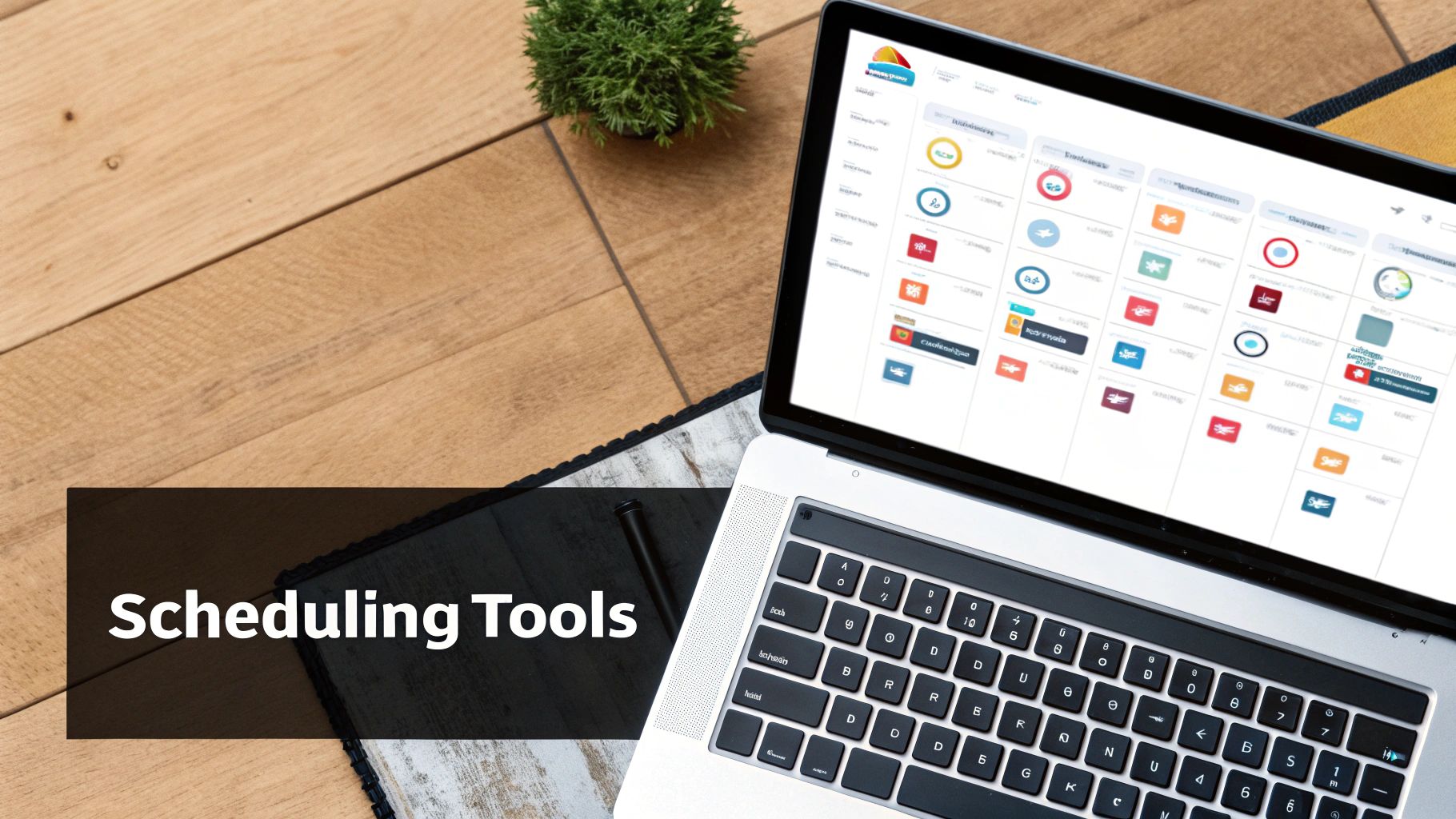
Trying to hit that ideal social media posting frequency can feel like you’re running on a content treadmill. You publish one post, and immediately, the pressure is on for the next one. This constant demand is a surefire recipe for creative burnout, forcing you to choose between consistency and quality.
But what if you could stay consistent without having to create brand-new content every single day? This is where evergreen content becomes your secret weapon.
What Is Evergreen Content?
Think of evergreen content as the foundational, timeless pieces in your content arsenal. It’s the stuff that’s just as helpful and relevant a year from now as it is today. Unlike a trending topic or a news-related post that quickly becomes dated, evergreen content addresses the core questions and recurring problems your audience always has.
It’s the sturdy, reliable material that forms the backbone of your expertise. These are your ultimate guides, your how-to articles, and your fundamental explainers that never go out of style.
Evergreen content is your key to a sustainable posting schedule. It perfectly fills the gaps in your calendar, keeps your profiles active with genuinely helpful material, and saves you from that last-minute scramble for ideas.
This approach ensures you’re always delivering value, even on days when fresh inspiration just isn't there. It’s a concept that fits right in with broader marketing philosophies, like the essential omnichannel marketing strategies that stress a consistent brand presence across all channels.
Automating Your Timeless Posts
The real magic happens when you pair evergreen content with automation. Instead of manually digging up old posts to reshare, you can let a smart tool do the heavy lifting for you.
Imagine building a library of your best, most timeless content—all those fantastic blog posts, insightful tips, and helpful guides. Then, you set up a system that automatically pulls from this library and shares posts on a schedule you control.
This is precisely what a tool like EvergreenFeed was built for. You can sort your content into different "buckets" (like "How-To Guides," "Company Culture," or "Quick Tips") and then set a unique posting schedule for each category. From there, the tool takes over, making sure your feed is always populated with great content.

The power here is in the details. You can maintain different cadences for different types of content, giving you incredible control over your posting strategy without the manual effort.
The Benefits of an Evergreen System
For any busy marketer or business owner, putting an automated evergreen system in place is a game-changer. It’s about working smarter, not harder.
- Saves a Ton of Time: You'll spend far less time on the repetitive grind of scheduling and more time creating the next big piece of content.
- Fills Your Content Calendar: Say goodbye to the fear of your social media feeds going dark. Your evergreen library ensures there’s always something valuable going out.
- Maximizes Your Content's Value: Why should a fantastic blog post only get one day in the spotlight? An evergreen system ensures your best work continues to drive engagement and traffic for months or even years.
By building this kind of system, you can finally find a sustainable rhythm that keeps your audience hooked without burning you out. To learn more, check out our in-depth guide on how to automate social media posts and put your content to work 24/7.
Common Questions About Posting Frequency
Even with the best-laid plans, questions about how often to post on social media always come up. It's totally normal. The digital space is always shifting, and a strategy that worked wonders last month might need a little adjustment today. This section is all about tackling those specific, practical questions that pop into your head after you've set up your initial schedule.
Think of this as your go-to guide for those "what if" moments. We'll give you straight, experience-based answers to help you manage your social media calendar with confidence.
Can I Post Too Much on Social Media?
You absolutely can, and it's one of the easiest traps to fall into. Picture your social feed as a friendly conversation at a party. If one person is constantly shouting and never letting anyone else speak, people will start to tune them out and walk away. That's exactly what happens on social media, a phenomenon known as content fatigue.
When you bombard your followers with too much low-value content, a few things happen, and none of them are good:
- You'll Annoy Your Followers: This is the most obvious outcome. Overwhelm your audience, and they won't hesitate to hit the mute or unfollow button.
- You'll Get Diminishing Returns: Platform algorithms are smart. If they see your engagement rate per post plummeting—which often happens with filler content—they might show your posts to fewer people.
- You'll Dilute Your Brand: Constant posting can make your brand look spammy or desperate for attention, chipping away at the quality image you've worked so hard to build.
The real takeaway here is that more posts don't automatically equal more engagement. In fact, some studies show that just two high-quality posts a week on Facebook can drive fantastic results. It’s solid proof that value always wins over volume.
What if I Can’t Keep Up with the Recommended Frequency?
This is a worry for just about every small business owner or solo marketer out there. Seeing recommendations like posting 2-3 times a day on a platform like X (formerly Twitter) can feel completely overwhelming.
Here’s the most important thing to remember: consistency is more important than frequency.
If all you can realistically manage is three fantastic, genuinely helpful posts a week, that's infinitely better than scrambling to push out ten mediocre ones. A frantic burst of activity followed by days of silence just confuses your audience and the algorithm.
A steady, predictable rhythm builds trust. Your followers start to learn when to expect content from you, and algorithms tend to favor accounts that are reliably active. Don't burn yourself out trying to keep up with a huge corporation. Find a pace that works for you and stick with it.
Should My Posting Frequency Change During Holidays or Special Events?
Yes, it definitely should! Holidays, big sales events, or major industry conferences are perfect opportunities to shake up your usual posting schedule. During these times, people are more active online, and conversations around specific topics explode.
Here’s a simple way to approach it:
- Plan Ahead: Get those key dates on your calendar early and map out your campaign content well in advance.
- Increase Frequency Strategically: You can temporarily ramp up your posting to share timely deals, behind-the-scenes glimpses, or live event updates.
- Monitor the Conversation: Use social listening to keep an eye on relevant hashtags and discussions. This lets you jump into conversations and engage in real-time.
A great example is a retail brand. In the week before Black Friday, they might boost their posting on Instagram and Facebook to showcase a different deal each day. Once the sale is over, they can settle back into their normal, sustainable rhythm.
Frequently Asked Questions
Even with these tips, you might have a few more specific questions. Here are some of the most common ones we hear, all in one place.
| Question | Answer |
|---|---|
| Does posting time matter more than posting frequency? | They're two sides of the same coin. Frequency is how often you show up, but timing is about who sees it. Posting at 3 AM won't do much good if your audience is in bed. Use your platform's analytics to find when your followers are most active and schedule your posts for those peak times. |
| How do I find my own "perfect" frequency? | Start with the general best practices for each platform, then treat it as a baseline. Test it for a few weeks, check your analytics (engagement rate, reach, follower growth), and adjust. If engagement drops, you might be posting too much. If your growth is slow, you might have room to post more high-quality content. |
| Should B2B and B2C companies have different posting frequencies? | Generally, yes. B2C brands often post more frequently, especially on platforms like Instagram and Facebook, to stay top-of-mind for impulse buys and lifestyle content. B2B companies, especially on LinkedIn, tend to focus more on in-depth, high-value content, so they may post less often but with more substance. |
Ultimately, finding the right social media posting frequency is a process of testing and learning.
Managing all of this is a constant balancing act, but it doesn't have to be a daily grind. With a tool like EvergreenFeed, you can build a library of your best timeless content and let automation fill the gaps in your calendar. This keeps your profiles active with high-quality posts, saving you hours of work while your audience stays engaged.
Ready to put your content on autopilot? Start automating your evergreen posts today with EvergreenFeed.

